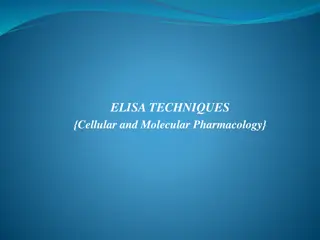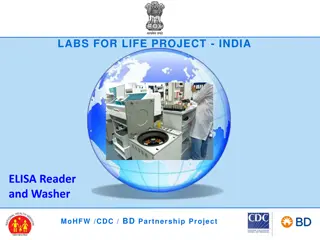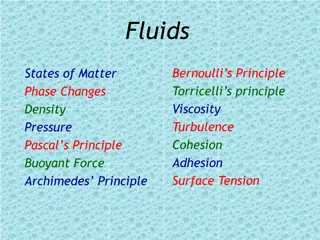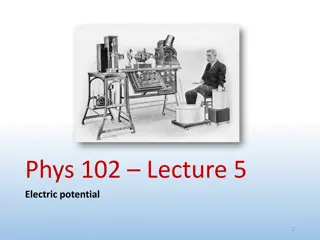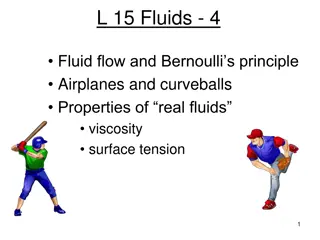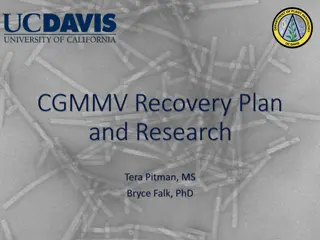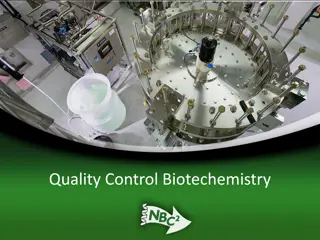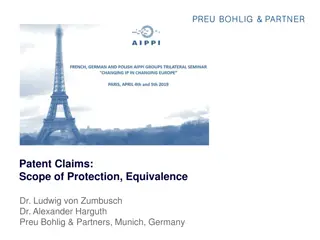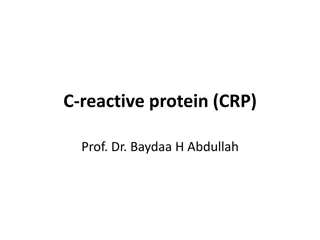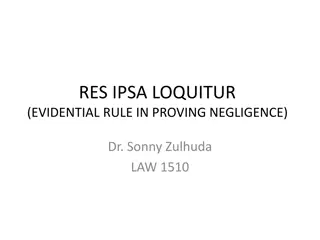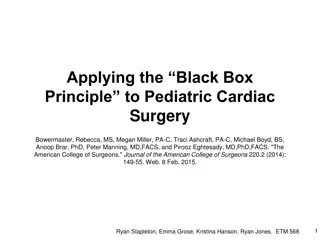Understanding ELISA: Principle, Types, and Applications
ELISA (enzyme-linked immunosorbent assay) is a widely used laboratory technique for detecting and quantifying antigens or antibodies in blood samples. Introduced in 1971, ELISA involves an antigen-antibody reaction using enzyme-conjugated antibodies to generate a colored product on a plate. There are four main types of ELISA: Direct, Indirect, Sandwich, and Competitive, each based on different binding structures between antibodies and antigens. This technology offers increased sensitivity and versatility, making it a valuable tool in various research and diagnostic applications.
Download Presentation

Please find below an Image/Link to download the presentation.
The content on the website is provided AS IS for your information and personal use only. It may not be sold, licensed, or shared on other websites without obtaining consent from the author. Download presentation by click this link. If you encounter any issues during the download, it is possible that the publisher has removed the file from their server.
E N D
Presentation Transcript
ELISA ELISA- - Principle, Types and Principle, Types and Applications Applications
ELISA(enzyme-linked immunosorbent assay) is an antigen antibody reaction. In 1971, ELISA was introduced by Peter Perlmann and Eva Engvall at Stockholm University in Sweden. It is a common laboratory technique which is usually used to measure the concentration of antibodies or antigens in blood. ELISA is a plate based assay technique which is used for detecting and quantifying substances such as peptides, proteins, antibodies and hormones. An enzyme conjugated with an antibody reacts with colorless substrate to generate a colored product. Such substrate is called chromogenic substrate. A number of enzymes have been used for ELISA such as alkaline phosphatase, horse radish peroxidase and beta galactosidase. Specific substrate such as ortho- phenyldiamine dihydrochloride (for peroxidase), paranitrophenyl phosphate (for alkaline phosphatase) are used which are hydrolysed by above enzymes to give colored end product
Types of ELISA Frequently there are 4 types of ELISA on the basis of binding structure between the Antibody and Antigen. Direct ELISA Indirect ELISA Sandwich ELISA Competitive ELISA
Direct ELISA A direct immunosorbent assay intended for the detection and quantification of a specific analyte (e.g. antigens, antibodies, proteins, hormones, peptides, etc.) from within a complex biological sample. Of the four different ELISA formats, direct ELISA is the simplest and quickest to perform, but there are some disadvantages associated with this method ELISA (enzyme-linked immunosorbent assay) is a plate-based
Indirect ELISA Antibody can be detected or quantitatively determined by indirect ELISA. In this technique, antigen is coated on the microtiter well. Serum or some other sample containing primary antibody is added to the microtiter well and allowed to react with the coated antigen. Any free primary antibody is washed away and the bound antibody to the antigen is detected by adding an enzyme conjugated secondary antibody that binds to the primary antibody. Unbound secondary antibody is then washed away and a specific substrate for the enzyme is added. Enzyme hydrolyzes the substrate to form colored products. The amount of colored end product is measured by spectrophotometric plate readers that can measure the absorbance of all the wells of 96-well plate.
Advantages Increased sensitivity, since more than one labeled antibody is bound per primary antibody. A wide variety of labeled secondary antibodies are available commercially. Maximum immunoreactivity of the primary antibody is retained because it is not labeled. Versatile because many primary antibodies can be made in one species and the same labeled secondary antibody can be used for detection. Flexibility, since different primary detection antibodies can be used with a single labeled secondary antibody. Cost savings, since fewer labeled antibodies are required. Different visualization markers can be used with the same primary antibody. Disadvantages Cross-reactivity might occur with the secondary antibody, resulting in nonspecific signal. An extra incubation step is required in the procedure.
Sandwich ELISA Sandwich ELISA Antigen can be detected by sandwich ELISA. In this technique, antibody is coated on the microtiter well. A sample containing antigen is added to the well and allowed to react with the antibody attached to the well, forming antigen- antibody complex. After the well is washed, a second enzyme-linked antibody specific for a different epitope on the antigen is added and allowed to react with the bound antigen. Then after unbound secondary antibody is removed by washing. Finally substrate is added to the plate which is hydrolyzed by enzyme to form colored products Sandwich ELISA
Advantages High specificity, since two antibodies are used the antigen is specifically captured and detected. Suitable for complex samples, since the antigen does not require purification prior to measurement. Flexibility and sensitivity, since both direct and indirect detection methods can be used.
Competitive ELISA Competitive ELISA This test is used to measure the concentration of an antigen in a sample. In this test, antibody is first incubated in solution with a sample containing antigen. The antigen-antibody mixture is then added to the microtitre well which is coated with antigen. The more the antigen present in the sample, the less free antibody will be available to bind to the antigen-coated well. After the well is washed, enzyme conjugated secondary antibody specific for isotype of the primary antibody is added to determine the amount of primary antibody bound to the well. The higher the concentration of antigen in the sample, the lower the absorbance.
Advantages High specificity, since two antibodies are used. High sensitivity, since both direct and indirect detection methods can be used. Suitable for complex samples, since the antigen does not require purification prior to measurement. Application of ELISA Presence of antigen or the presence of antibody in a sample can be evaluated. Determination of serum antibody concentrations in a virus test. Used in food industry when detecting potential food allergens. Applied in disease outbreaks- tracking the spread of disease e.g. HIV, bird flu, common, colds, cholera, STD etc.
Radioimmunoassay- Principle, Uses and Limitations When radioisotopes instead of enzymes are used as labels to be conjugated with antigens or antibodies, the technique of detection of the antigen antibody complex is called as radioimmunoassay (RIA). Radioimmunoassay (RIA) is an in vitro assay that measures the presence of an antigen with very high sensitivity. RIA was first described in 1960 for measurement of endogenous plasma insulin by Solomon Berson and Rosalyn Yalow of the Veterans Administration Hospital in New York.
The Uses and limitations of the RIAinclude: USES 1.The test can be used to determine very small quantities (e.g. nanogram) of antigens and antibodies in the serum. 2.The test is used for quantitation of hormones, drugs, HBsAg, and other viral antigens. 3.Analyze nanomolar and picomolar concentrations of hormones in biological fluids. limitations : High Cost of equipment and reagents Short shelf-life of radiolabeled compounds The problems associated with the disposal of radioactive waste.


